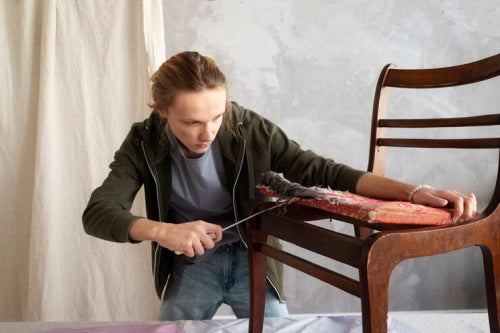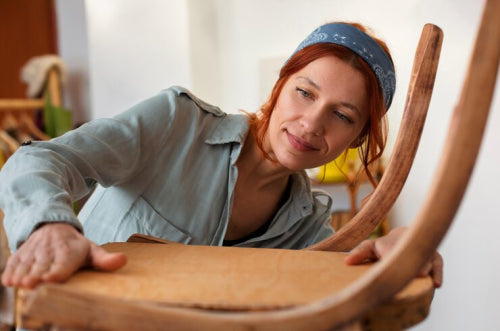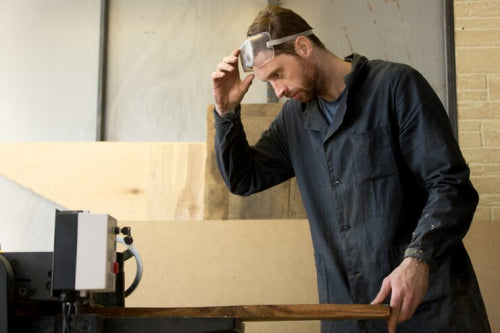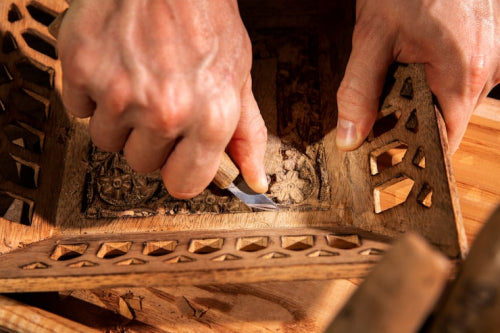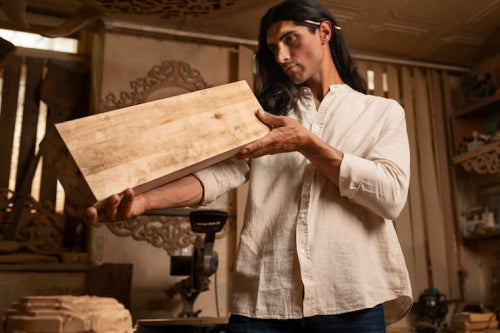Inside a bustling Bangalore workshop, the air is thick with the aroma of freshly planed teak, undercut by the soft whir of a laptop running design software. An artisan, mentored by family tradition, etches delicate motifs into a chair's frame, while a designer nearby refines a digital blueprint for a sleek, modular cabinet. This seamless blend of heritage and innovation is no outlier it's the pulse of a vibrant resurgence transforming India's urban centers. From Jaipur's storied craft villages to Mumbai's dynamic design markets, a new wave of artisans is redefining handcrafted furniture, merging India's woodworking legacy with modern sensibilities.
Mass-market furniture lacks heart, filling rooms with bland, short-lived pieces. Frequent breakdowns spark frustration, as replacements erode style and sentiment. At MMC Wood Creations, Udaipur artisans shape heirloom furniture with enduring craftsmanship and cozy elegance, creating pieces that echo your identity, ensuring your home radiates warmth and timeless connection. Shop Now!
The Arts and Crafts Revival: How Indian Cities Are Redefining Handcrafted Furniture
India's furniture industry is experiencing a renaissance, one that echoes the 19th-century Arts and Crafts movement's reverence for handcrafted excellence over industrial uniformity. Yet, this revival is uniquely Indian, grounded in centuries-old woodworking traditions and driven by urban demand for sustainable, bespoke creations. The Crafts Council of India reports an 8–10% annual increase in handcrafted furniture exports from Rajasthan and Karnataka between 2022 and 2024, signaling global appreciation for India's artisanal prowess. In cities like Bangalore, Mumbai, and Pune, discerning consumers are shunning mass-produced imports, gravitating toward pieces that embody craftsmanship, culture, and environmental consciousness.
Leading this charge are workshops like MMC Wood Creations, which fuse time-honored techniques with contemporary design. Their mission reviving India's artisanal heritage while crafting furniture that fits the practical and aesthetic needs of modern urban life captures the essence of this movement. As the global arts and crafts market, valued at USD 43.4 billion in 2023, is projected to reach USD 79.2 billion by 2030 with a CAGR of 8.96%, India's role as a hub for handcrafted excellence is undeniable.
Bangalore: The Fusion of Tech and Craft
In Bangalore, India's tech epicenter, artisans are proving that tradition and innovation can coexist harmoniously. Workshops in vibrant neighborhoods like Indiranagar and Whitefield combine CAD design tools with age-old woodturning techniques to craft modular furniture from reclaimed teak and Sheesham. The National Institute of Design in Bangalore highlights a boom in urban maker-spaces, where artisan-entrepreneurs experiment with eco-friendly materials. One pioneering startup has integrated IoT humidity sensors into its wood-curing process, cutting material waste by 15%, according to research from the Indian Institute of Science's Centre for Sustainable Technologies.
This marriage of technology and craft isn't just about efficiency it's about preserving artistry in a city defined by rapid progress. Crafting a single dining table from reclaimed wood can take weeks, but its durability and unique character outshine factory-made alternatives. For Bangalore's eco-conscious urbanites, these pieces are more than furniture; they're a testament to sustainable living and cultural pride.
The global arts and crafts market, which reached $44.47 billion in 2024, underscores the growing appetite for handcrafted goods. In Bangalore, this trend is amplified by a DIY culture that encourages consumers to value the story behind each piece, from the artisan's hands to the sustainable materials used.
Jaipur: The Artisanal Core of India
In Jaipur, the revival takes on a richer, more traditional tone. Renowned for its carved teak and intricate inlay work, the city remains a cornerstone of India's craft heritage. According to the Export Promotion Council for Handicrafts, Jaipur's export clusters contributed over 20% of India's handcrafted wooden furniture exports in 2023. In areas like Sanganer, workshops are breathing new life into ancient techniques, hand-carving Sheesham with eco-friendly, low-VOC finishes while leveraging digital platforms to reach international buyers.
Government support, through initiatives like the Rajasthan Small Industries Corporation (RAJSICO), is bolstering this growth by funding artisan cooperatives. These efforts have sparked collaborations between master craftsmen and contemporary designers, whose creations now adorn boutique resorts across Rajasthan and beyond. The result is furniture that feels both timeless and modern imagine an intricately carved teak headboard paired with clean, minimalist lines, blending heritage with urban elegance.
Mumbai and Pune: Design Hubs for the Eco-Conscious
In Mumbai, the revival unfolds in the lively markets of Kala Ghoda and Bandra, where limited-edition artisan furniture is capturing attention. Shoppers here aren't merely purchasing a chair or a side table they're investing in a piece of India's creative legacy. In Pune, design startups are championing sustainable joinery, using native woods like Acacia and Mango to craft bespoke pieces. The Maharashtra State Handicrafts Council notes a surge in B2B orders from architecture firms since 2022, signaling that handcrafted furniture is gaining traction in larger commercial projects.
Beyond aesthetics, these cities are home to consumers who prioritize sustainability. A handcrafted Acacia bench, for instance, represents more than beauty it's a commitment to responsible sourcing and local craftsmanship. This aligns with broader trends, as 72% of U.S. adults engaged in crafting activities in the past year, driven by motivations like sustainability and stress relief, a sentiment echoed in India's urban centers.
Emerging Craft Centers: Chennai, Hyderabad, and Beyond
The revival extends beyond India's metropolitan giants. In Chennai, the Kalakshetra Foundation's Design School is training artisans to blend traditional woodcraft with modern design principles. Hyderabad's workshops are pioneering a hybrid approach, using CNC precision cutting alongside hand-finishing to create bespoke furniture. In Kolkata, studios in Salt Lake and Park Street are reimagining mid-century colonial pieces, infusing them with fresh textures and ergonomic designs. Meanwhile, Ahmedabad's CEPT University is driving research into sustainable materials and traditional joinery, ensuring that India's craft heritage evolves with the times.
These emerging hubs reflect a growing consumer interest in crafts as a form of escapism and affordability, a trend mirrored globally where nearly half of U.S. adults report using crafts to unwind from stress, per Mintel's 2024 insights.
Challenges Facing the Revival
Despite its momentum, the revival faces significant challenges. Sourcing sustainable hardwoods, such as FSC/PEFC-certified timber, remains a hurdle due to limited supply. Artisan attrition is another concern, with the National Skill Development Corporation (NSDC) noting that younger generations in Rajasthan and Karnataka are increasingly abandoning traditional trades for urban opportunities. Market fragmentation persists, with tier-1 cities lacking centralized retail channels for artisanal furniture. Additionally, in cities like Hyderabad and Pune, some consumers still perceive handcrafted pieces as prohibitively expensive, a misconception artisans are working to dispel.
Opportunities for a Thriving Future
The opportunities, however, are immense. The Invest India and EPCH forecast that India's handcrafted wooden furniture market could reach USD 3.8 billion by 2030, growing at a CAGR of 8.7%. Boutique hotels in Jaipur, Goa, and Chennai are increasingly sourcing locally crafted décor to attract eco-conscious travelers. Partnerships between craft clusters and institutions like NID, CEPT, and NIFT are fostering knowledge transfer, ensuring that traditional skills endure. Meanwhile, digital marketplaces in Ahmedabad and Bangalore are democratizing access to artisan furniture, connecting craftsmen directly with global consumers.
A Lasting Legacy: Crafting India's Future
India's handcrafted furniture revival is more than a market trend it's a cultural and environmental movement. As the All India Handicrafts Board stated in 2024, “India's wooden craft revival is increasingly defined by design empathy and technological collaboration.” By 2030, studios in Jaipur, Bangalore, and Ahmedabad are poised to lead not only in economic impact but in preserving India's cultural identity. Each piece whether a hand-carved teak chair or a sleek Sheesham console carries the weight of tradition and the promise of sustainability. In an era dominated by mass production, India's artisans are proving that craftsmanship is not just an industry but a vital thread in the fabric of cultural preservation.
Frequently Asked Questions
What is driving the arts and crafts revival in India's handcrafted furniture industry?
The revival is driven by urban consumers seeking sustainable, bespoke furniture that embodies craftsmanship and cultural heritage over mass-produced alternatives. Indian cities like Bangalore, Jaipur, and Mumbai are experiencing an 8–10% annual increase in handcrafted furniture exports, fueled by global demand for artisanal excellence. This movement blends centuries-old woodworking traditions with modern design sensibilities and eco-friendly materials, creating furniture that appeals to environmentally conscious buyers.
How are Indian artisans combining traditional craftsmanship with modern technology?
Artisans in cities like Bangalore are seamlessly integrating CAD design tools, CNC precision cutting, and even IoT humidity sensors with traditional techniques like hand-carving and woodturning. This fusion allows them to create modular furniture from reclaimed teak and Sheesham while reducing material waste by up to 15%. The approach preserves the artistry and unique character of handcrafted pieces while improving efficiency and meeting contemporary design needs.
What challenges does India's handcrafted furniture industry face despite its growth?
The industry faces challenges including limited access to FSC/PEFC-certified sustainable hardwoods, artisan attrition as younger generations leave traditional trades for urban jobs, and market fragmentation with few centralized retail channels in tier-1 cities. Additionally, consumer misconceptions about high costs persist in some markets. However, opportunities abound, with the market projected to reach USD 3.8 billion by 2030, driven by boutique hospitality demand, digital marketplaces, and partnerships between craft clusters and design institutions.
Disclaimer: The above helpful resources content contains personal opinions and experiences. The information provided is for general knowledge and does not constitute professional advice.
You may also be interested in: Natural Wood Finishes That Enhance Home Interiors
Mass-market furniture lacks heart, filling rooms with bland, short-lived pieces. Frequent breakdowns spark frustration, as replacements erode style and sentiment. At MMC Wood Creations, Udaipur artisans shape heirloom furniture with enduring craftsmanship and cozy elegance, creating pieces that echo your identity, ensuring your home radiates warmth and timeless connection. Shop Now!
Powered by flareAI.co
